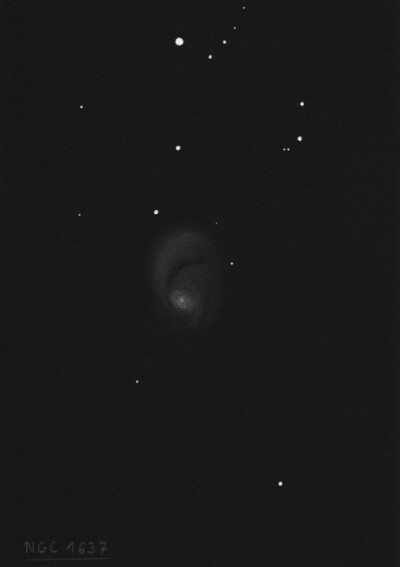
William Herschel discovered NGC 1637 = H I-122 = h327 on 1 Feb 1786 (sweep 518) and reported "cB, vL, iR, bM, easily resolvable, 5' or 6' diameter." John Herschel made two observations from Slough, England ? once describing it as "bright" and another time as "pretty faint". Fifteen observations were made at Birr Castle and noted as a spiral on 19 Dec 1848 (included in the LdR's 1850 list of "Spiral or curvilinear" nebulae). R.J. Mitchell, observing on 26 Dec 1856, added "Suspect very strongly that it is a right handed spiral, but the outlying neby is vF." He made a sketch two nights later (LdR's 1861 publication, Plate XXV, figure 9).
Albert Le Sueur sketched it using the 48" Melbourne Telescope with an elongated core (WSW-ENE) offset to the south side (halo more extensive to the north) and subtle structure in the halo (unpublished plate VII, figure 83). It was later observed by both Joseph Turner and Pietro Baracchi (11 Mar 1885).
200/250mm - 8" (10/4/80): faint, oval, fairly small.
300/350mm - 13.1" (12/18/82): fairly faint, large, diffuse, elongated 4:3 SW-NE, weak concentration. A mag 13 star is 2.1' NE of center. Located midway between Mu Eridani (V = 4.0) 1? ESE and 51 Eridani (V = 5.2) 1? WNW.
900/1200mm - 48" (11/2/13): bright, large, slightly elongated SSW-NNE, 3'x2.5'. Contains a large bright core with an elongated bright nucleus that appears to be a bar oriented E-W. The appearance is quite irregular due a thick, fairly prominent spiral arm that curves north-south along the eastern side of the halo and bending west as it curves counterclockwise on the north side. A darker gap was evident between the slightly brighter inner edge of this thick arm and the core. A small section of another spiral arm is attached at the SW side of the core. The SW side of the halo is fainter and not as extensive as the NE side, so the galaxy has a lopsided appearance.
Notes by Steve Gottlieb